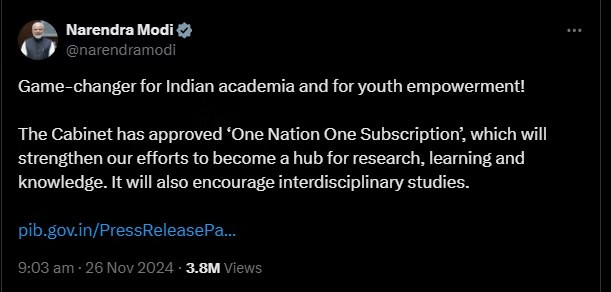Hello friends, I am sure you’ve been hearing about the “One Nation One Subscription” initiative for the past few days. Even Prime Minister Modi tweeted about it, saying it could be a game-changer for Indian academia and youth empowerment. You can see his statement highlighting that the Cabinet has approved the One Nation, One Subscription initiative, which aims to strengthen research and development efforts and provide greater access to journals, encouraging studies.
Table of Contents
What exactly is One Nation One Subscription initiative?
Let’s start by understanding what has happened. Recently, the Union Cabinet approved the One Nation, One Subscription initiative. What does this entail? As you may know, research conducted globally is often published in journals. Conducting research and development is a costly affair, requiring years of hard work from scientists to yield results. These findings are published in journals, but the key question is whether or not students and researchers in India can access these journals.
In India, the government often focuses on issues like poverty alleviation and other priorities, but research and development don’t always receive enough attention. Now imagine, India has numerous higher education institutions where millions of students study. Do they have access to these prestigious journals? Without access, how can they pursue advanced studies?
To address this, the government has allocated ₹66,000 crores for three years (2025–2027) to provide access to these journals and support the country’s higher education and research institutions, whether they come under state governments, central government, or independent research institutions.
What is “One Nation One Subscription”?
This is essentially a plan to consolidate subscriptions to prominent academic journals and similar publications. The aim is to ensure that students and researchers in India can access world-class journals from a single platform.
For example, while preparing educational videos, we often refer to newspapers and articles, which require subscriptions. Whether it’s The Hindu or international publications like The Economist or Nikkei, we need individual subscriptions for each, which are often expensive—ranging from ₹1,000 to ₹20,000 annually. Similarly, students in higher education institutions need access to academic journals.
Until now, institutions had to subscribe to journals individually, which was expensive. The government has decided to consolidate subscriptions for all major journals globally, making them accessible to students and researchers across India.
How can it benefit nearly 20 million Indians?
In 2018, Indian institutions spent ₹4,000 crores on subscriptions alone, with each institution spending an additional ₹30–50 crores to access databases. In fact, during a 2023 Lok Sabha session, the Minister of State for Education revealed that the Indian government spent ₹995 crores in 2022 on journal subscriptions.
This consolidated initiative will significantly reduce costs and ensure that the benefits reach students, researchers, and institutions nationwide.




